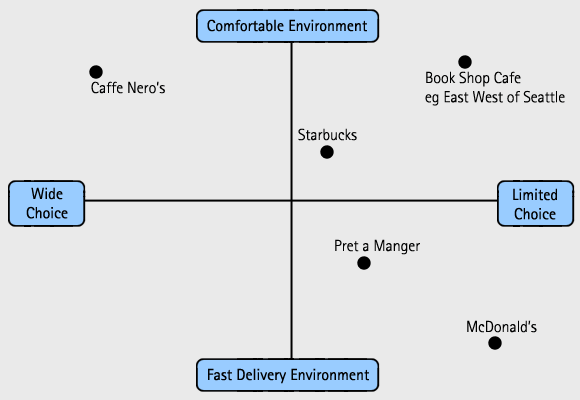 To a small local business, marketing words such as ‘brand identity’, ‘positioning’ and ‘USP’ can be perceived as rather intimidating jargon often thought to only be appropriate to and made use of by the likes of Heinz and M&S, or the large corporate businesses that have gone to great lengths to develop a shrewd and complex business strategy over the course of many long and intense hours of board room meetings and performance review sessions. However, as a fellow small business who works closely with a variety of other small businesses on a weekly basis, I would like to argue an alternative viewpoint; that taking a bit of time to think about the identity and ‘feel’ of your business may be an invaluable exercise to ensuring you and your business are set to work effectively in the environment you find yourselves in. But don’t worry – no board room pomp or suited and booted attire is required. Just put the kettle on and make yourself a brew, grab a notebook and pen and simply ask yourself the following 4 questions:
To a small local business, marketing words such as ‘brand identity’, ‘positioning’ and ‘USP’ can be perceived as rather intimidating jargon often thought to only be appropriate to and made use of by the likes of Heinz and M&S, or the large corporate businesses that have gone to great lengths to develop a shrewd and complex business strategy over the course of many long and intense hours of board room meetings and performance review sessions. However, as a fellow small business who works closely with a variety of other small businesses on a weekly basis, I would like to argue an alternative viewpoint; that taking a bit of time to think about the identity and ‘feel’ of your business may be an invaluable exercise to ensuring you and your business are set to work effectively in the environment you find yourselves in. But don’t worry – no board room pomp or suited and booted attire is required. Just put the kettle on and make yourself a brew, grab a notebook and pen and simply ask yourself the following 4 questions:
1. Put simply, how would you like your business to be viewed? Is your business no-nonsense and to-the point? Is it fun and quirky? It is approachable and friendly? Is it fighting your customers’ corner? Is it environmentally conscious? Is it convenient with lots of choice? Is it budget-aware and cost-effective? Try to sum up your business identity or standpoint in less than a dozen words. What does it ‘feel like’? What do you want it to most be remembered for? If your business was a famous personality who would it be? You get the picture. But whoa there horsey! Don’t set your heart on this identity quite yet, as there are some other important questions to answer first…
2. Does my business identity possess qualities my target market is interested in? It’s no good positioning yourself as environmentally-friendly if your customers generally aren’t very eco-friendly and don’t care whether or not your product is made from recycled materials or if your service has a low carbon footprint. Have a think about what matters to your ideal customer, both generally and what they more specifically would care about from your product or service. Then make sure the way you promote and sell your product or service reflects the very things they care about. Don’t attempt to try to be all things to all men – inevitably there will always be some people who aren’t interested in the selling points you go for. Better to run with a small number of benefits to delight the customers who will be interested.
3. Does my business identity reflect qualities that outdo my competitors? This is where sketching out a number of positioning maps can be quite helpful. See the example below of a positioning map for choice of American coffee places. You need to think about how the main selling points of your business (reflected in your brand identity) give you some sort of advantage over your competitors. Take a couple of the main qualities you would like your business to be perceived to have, and use these as the X and Y axes on your positioning map. Then plot where you think you and your competitors sit according to these qualities. This will help to you to easily identify which of your competitors are trying to promote the same selling points as you, and whether the way you plan to position your business is already being done by several others and perhaps you need to consider re-positioning and offering some alternative benefits and selling points so placing you somewhere which is less competitively fierce.
So just to sum up where we’ve go to so far, you need to decide on how you wish your business to be viewed and perceived in terms of its key qualities, make sure this is based on things your customers actually want and also ensure that these qualities allow you to outdo most of your competition in some way.
4. Finally, is your business identity reflected in everything you do and say? The posh term for this is Integrated Marketing Communications. The way to build up a really strong and clear reputation for your business is once you have decided on a position, run with it to make sure it informs everything else in your business. This means making sure your latest brochure design reflects the qualities of your business, in both its content and design. It will mean thinking about the language you use when sending out your regular mailshots, and even what you wear to business networking meetings! It will also mean thinking about what promotional activities your business chooses to engage in; if you want to be seen as knowledgeable and experts in your field, then why not start a blog or run a series of workshops to communicate this quality to potential customers? Sending out mixed or contradictory messages about your business is generally bad news, so make sure that all your channels of communication between your business and the outside world – both verbal and non-verbal – align well with the overall ‘feel’ of your business.
I hope that this has been helpful reading in introducing you to the idea of thinking through your business identity, and the benefits of doing so even if you’re not as big as Heinz! Thanks for reading, and give me a shout if I can help in any way.
See you soon!
![]()
One of the services Back Room SAM offers is an affordable 2-3 hour marketing strategy session structured ideally for small business owners. If you think this is something you and your business might benefit from, then please do drop me a line at sarah@backroomsam.co.uk.

